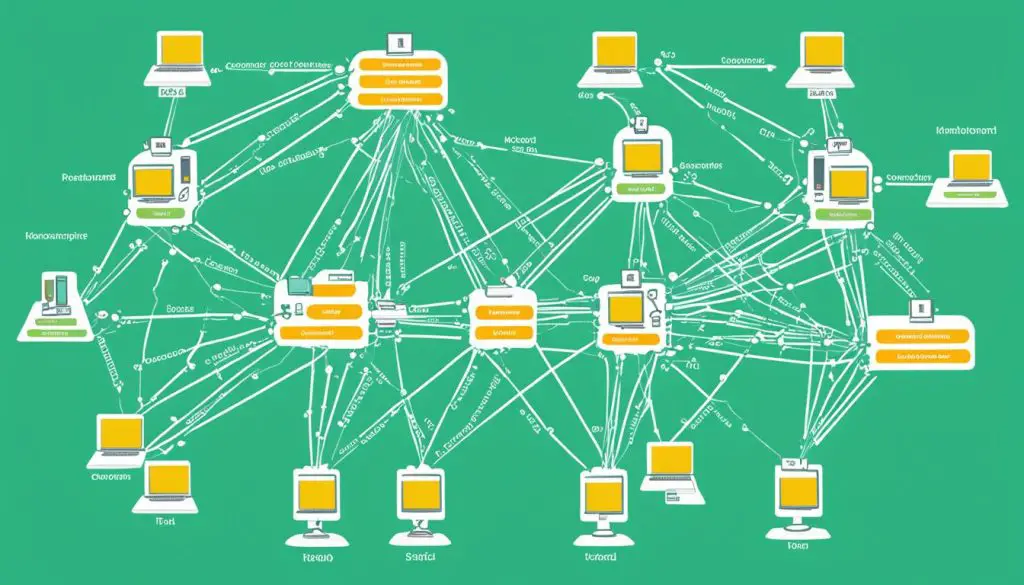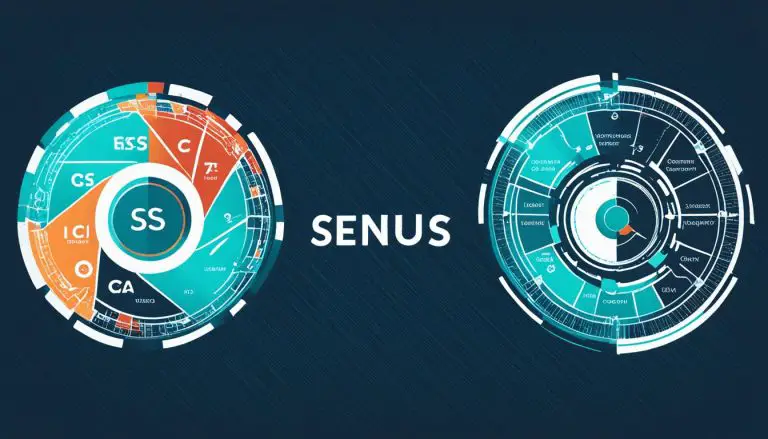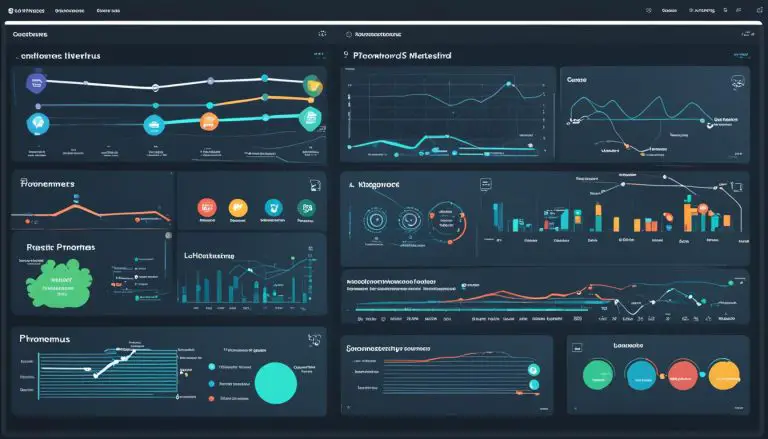Zabbix vs. Icinga: Unveiling the Best Monitoring Tool
When it comes to network monitoring tools, there are plenty of options available. But how do you choose the best one for your organization? Two popular choices for network monitoring are Zabbix and Icinga. Both are open-source tools with a range of features that can help you gain visibility into your network and ensure its smooth operation. But which one is better?
In this article, I will delve deep into the features, differences, and capabilities of Zabbix and Icinga to help you make an informed decision. Are you ready to uncover the best monitoring tool for your network? Let’s explore!
Key Takeaways:
- Zabbix and Icinga are popular open-source network monitoring tools.
- Both tools have a wide range of features to monitor and manage network infrastructure.
- Zabbix offers a user-friendly web interface and auto discovery.
- Icinga is known for its advanced features for monitoring complex networks.
- The choice between Zabbix and Icinga depends on your specific needs and requirements.
Brief Review of Nagios
Nagios is a well-established network monitoring tool that has been in existence since 1999. Over the years, it has evolved and expanded its capabilities to become a reliable choice for network administrators and IT professionals.
With Nagios, you have two versions to choose from: the free Nagios Core and the enterprise Nagios XI. Nagios Core is a robust network monitoring solution that enables you to monitor various components of your network, such as devices, servers, applications, and operating systems. It can operate in agentless mode, providing you with real-time analysis of network traffic.
The Nagios XI, on the other hand, is the enterprise version of Nagios. It offers an extended user interface with additional tools to enhance your monitoring experience. With its compatibility with enterprise tools like Active Directory and Oracle databases, Nagios XI provides seamless integration into your existing infrastructure.
The enterprise version of Nagios provides additional features and functionalities, including a customizable dashboard, capacity planning, and the ability to create trending graphs. These features allow you to gain valuable insights into your network’s performance and make informed decisions to optimize its efficiency.
Nagios also supports the integration of third-party applications through its vast collection of plugins. These plugins extend the functionality of Nagios, enabling you to monitor specific applications or services within your network environment.
Overall, Nagios is a comprehensive network monitoring tool trusted by thousands of organizations worldwide. Its flexibility, scalability, and extensive feature set make it a popular choice for both small and large networks.
Brief Review of Icinga
Icinga is a powerful network monitoring tool that is specifically designed to monitor large and complex networks, including data centers and cloud configurations. It offers comprehensive statistics and insights into the availability and statuses of network resources.
Icinga consists of two main components, namely the Icinga Server and the Icinga Web. These components work together to provide a robust and efficient network monitoring solution. The Icinga Server is responsible for collecting and processing data from various network devices and systems, while the Icinga Web provides a user-friendly interface for viewing and managing monitoring results.
One of the key advantages of Icinga is its modular architecture. It provides a range of modules and plugins that can be used to extend its capabilities and cater to specific monitoring requirements. For example, there are modules available for monitoring virtual machines, security certificates, and even business process modeling.
“Icinga is a reliable and flexible network monitoring tool that can be seamlessly integrated with third-party tools and systems.”
Integration is a breeze with Icinga. It supports integration with various third-party tools, including trouble ticketing systems, reporting software, and tools like Graphite or Jira. This allows users to streamline their workflow and access monitoring data from within their existing systems.
Configuration of Icinga can be managed in two ways. Users can opt for the Icinga Director, a user-friendly graphical configuration interface that simplifies the process of setting up and managing monitoring configurations. Alternatively, more advanced users can utilize the Icinga Domain Specific Language for configuration using plain text files.
Icinga Web provides customizable views and filtering options for monitoring results, ensuring that users can access the information they need at a glance. This flexibility and customization options make Icinga well-suited for organizations with complex network environments and diverse monitoring requirements.
With its robust features, scalability, and ability to handle large networks and complex configurations, Icinga is an excellent choice for organizations that require comprehensive network monitoring capabilities. Whether it’s monitoring data centers, cloud configurations, or other large network environments, Icinga delivers reliable and accurate statistics to ensure optimal network performance and availability.
Brief Review of Zabbix
Zabbix is a comprehensive network monitoring tool that provides real-time insights into network performance and infrastructure. With its advanced features and user-friendly interface, Zabbix is a preferred choice for organizations seeking robust network monitoring capabilities.
Zabbix offers:
- Auto Discovery: Zabbix’s auto discovery feature ensures that new and existing network devices are automatically detected and added to the monitoring system. This saves configuration time and eliminates the need for manual device addition.
- Wide Range of Protocols: Zabbix supports multiple protocols such as SNMP (Simple Network Management Protocol) and IPMI (Intelligent Platform Management Interface) for metric collection. This enables monitoring of various network parameters, including bandwidth usage, packet loss rate, memory utilization, and number of connections.
- Comprehensive Metrics: Zabbix provides an extensive range of metrics and indicators to monitor network performance. From real-time statistics to historical trends, Zabbix delivers valuable insights for effective network management and troubleshooting.
- Event Detection: Zabbix can detect network events like links being down or critical system status. This proactive monitoring approach ensures immediate notifications and faster incident resolution, minimizing downtime and improving overall network reliability.
- Flexible Configuration: Zabbix allows for the configuration of both active and passive nodes, providing flexibility in monitoring different network environments. Additionally, it supports the creation of logical expressions of monitored data, allowing for customized and targeted monitoring.
- Seamless Integration: Zabbix integrates easily with third-party software, making it compatible with existing monitoring tools and systems. It also provides secure communication, ensuring the confidentiality and integrity of monitoring data.
- Scalability: Zabbix is highly scalable and can accommodate networks of varying sizes. It can be extended to serve very large networks using a proxy server architecture, making it suitable for enterprises with complex network infrastructures.
Zabbix is a powerful and versatile network monitoring tool that empowers organizations to effectively monitor their networks, troubleshoot issues, and ensure optimal performance. With its extensive feature set and scalability, Zabbix is a valuable asset in maintaining a robust and reliable network infrastructure.
Zabbix vs. Nagios: Key Features
When comparing Zabbix and Nagios, both tools offer key features that are crucial for effective network monitoring.
Configuration
Zabbix provides a web-based interface that makes configuration changes easy and convenient. On the other hand, Nagios requires manual configuration through text files.
User Interface
Zabbix boasts a modern and full-blown web interface that allows for seamless configuration. In contrast, Nagios has a web interface, but it only offers basic monitoring and reporting capabilities.
Alerting
Both Zabbix and Nagios offer alerting features through email and/or SMS, ensuring that administrators remain informed about critical events.
Main Protocol Monitoring
Both tools support monitoring of essential protocols such as SSH, HTTP, FTP, POP3, SMTP, SNMP, and MySQL, enabling comprehensive network monitoring.
Graphs
Zabbix comes with pre-built graphs out of the box, allowing administrators to visualize and analyze data easily. Nagios, on the other hand, requires the use of the NagVis plugin to generate graphs.
Log Monitoring
Zabbix has built-in log monitoring capabilities, eliminating the need for additional tools. In contrast, Nagios requires the use of a Nagios log server for log monitoring.
Plugins
Nagios offers extensive plugin support, enabling users to enhance functionality with third-party plugins. Zabbix, however, does not have built-in plugin support.
Auto-Discovery
Both Zabbix and Nagios have auto-discovery capabilities, allowing for automated discovery and monitoring of new network devices.
Overall, Zabbix and Nagios offer powerful features for network monitoring, each with its own strengths and advantages. The choice between the two ultimately depends on the specific requirements and preferences of the organization.

Icinga vs. Nagios: Key Features
When comparing the key features of Icinga and Nagios for network monitoring, certain aspects stand out.
Configuration
Icinga allows easy configuration through the Icinga Director or plain text, whereas Nagios requires configuration through text files.
User Interface
Icinga boasts the more intuitive Icinga Web 2 interface, providing a seamless user experience. In contrast, Nagios Core offers a different web interface that may not be as user-friendly.
Alerting
Both Icinga and Nagios support alerting through email and/or SMS, ensuring timely notifications for critical events.
Main Protocol Monitoring
Both tools excel in supporting main protocol monitoring, including SSH, HTTP, FTP, POP3, SMTP, SNMP, and MySQL, ensuring comprehensive coverage of network services.
Graphs
While Nagios requires the NagVis plugin for graphing, Icinga offers integrated graphing capabilities using Grafana and Graphite modules.
Log Monitoring
Icinga does not have built-in log monitoring capabilities, while Nagios supports log monitoring with the Nagios log server for streamlined log analysis and troubleshooting.
Plugins
Both Icinga and Nagios support plugins, enabling users to extend the functionality of the monitoring tools according to their specific needs.
Auto-Discovery
Both tools offer auto-discovery capabilities, simplifying the process of identifying and monitoring new network devices and services.
When evaluating Icinga and Nagios, understanding the differences in their key features can help you make an informed decision about which tool is the best fit for your network monitoring requirements.
Open-Source Network Monitoring Tools
When it comes to network monitoring, open-source tools offer a cost-effective solution without compromising on functionality. In this section, I will introduce you to some of the top open-source network monitoring tools available.
Nagios XI
Nagios XI is the enterprise version of the popular Nagios network monitoring tool. It provides additional features and support, making it ideal for organizations with larger and more complex networks. With Nagios XI, you can monitor a wide range of devices and protocols, ensuring comprehensive visibility into your network infrastructure.
LibreNMS
LibreNMS is a flexible and user-friendly open-source network monitoring tool. It supports a wide range of devices and protocols, making it suitable for diverse network environments. With LibreNMS, you can easily monitor the performance and availability of your network components, set up alarms, and generate detailed reports.
Zabbix
Zabbix is a powerful open-source network monitoring tool that offers extensive functionality and customization options. It features auto discovery capabilities, allowing you to automatically detect and monitor new network devices. Zabbix also provides seamless integration with other tools and systems, making it a versatile choice for network monitoring and management.
OpenNMS
OpenNMS is a scalable and customizable open-source network monitoring and management platform. It offers advanced features for monitoring and managing large networks, making it suitable for organizations with complex network infrastructures. With OpenNMS, you can monitor network performance, track service availability, and proactively identify and resolve issues.
These open-source network monitoring tools provide robust solutions for monitoring and managing your network infrastructure. Whether you are a small organization or a large enterprise, these tools offer the flexibility, functionality, and cost-effectiveness you need to ensure the optimal performance of your network.
All-In-One IT Software Editors
When it comes to network monitoring, there are several all-in-one IT software editors that offer comprehensive solutions. These editors include Datadog, AppDynamics, Dynatrace, Splunk, New Relic, and Elastic Observability.
Datadog provides a cloud-based platform for monitoring network components and analyzing network traffic, offering a seamless and integrated experience for IT professionals.
AppDynamics specializes in application performance monitoring and user behavior monitoring, ensuring that your applications are running smoothly and providing a great user experience.
“Dynatrace takes an innovative approach to network monitoring, providing full-stack observability and AI-powered insights into your IT systems. With Dynatrace, you can proactively identify and resolve issues before they impact your business.”
Splunk offers a comprehensive platform for log management, security, and network monitoring. It enables you to gain valuable insights from your machine-generated data and enhance the security of your IT infrastructure.
New Relic focuses on application performance monitoring and cloud infrastructure monitoring, helping you optimize your applications and ensure the smooth operation of your cloud-based services.
Elastic Observability offers advanced monitoring and analysis of network performance and security, empowering IT teams to identify and address network issues promptly.
Why Choose an All-In-One Solution?
Opting for an all-in-one IT software editor for your network monitoring needs comes with several advantages. Firstly, it eliminates the need to work with multiple tools, streamlining your IT operations and reducing complexity.
Additionally, all-in-one solutions offer seamless integration between different monitoring functionalities, providing a holistic view of your network performance and ensuring efficient troubleshooting and issue resolution.
By choosing an all-in-one solution, you can save time and effort by having all the necessary tools and features in one place, ultimately enhancing productivity and enabling you to focus on other critical tasks.
Conclusion
In conclusion, both Zabbix and Icinga are powerful network monitoring tools with their own strengths and features. Zabbix offers a user-friendly web interface, auto discovery, and scalability, making it suitable for large networks. On the other hand, Icinga provides advanced features that are well-suited for monitoring complex networks, such as data centers and cloud configurations.
The choice between Zabbix and Icinga ultimately depends on the specific needs and requirements of your network monitoring environment. It is recommended to evaluate the features, differences, and compatibility with your existing infrastructure to determine which tool is the best fit for your organization. By carefully assessing the comparison of these network monitoring tools, you can make an informed decision that aligns with your network management objectives.
Whether you choose Zabbix or Icinga, both tools can significantly enhance your network monitoring capabilities, providing you with valuable insights into the performance and availability of your infrastructure. So, take your time to explore the features and functionalities they offer and choose the tool that meets your organization’s specific requirements and preferences.
FAQ
What is the difference between Zabbix and Icinga?
What is Nagios and what are its key features?
How does Icinga differ from Nagios?
What are the key features of Zabbix?
Are there any open-source alternatives to Nagios, Zabbix, and Icinga?
Are there any all-in-one IT software editors that offer network monitoring?
Source Links
- https://www.networkstraining.com/icinga-vs-zabbix-vs-nagios-comparison/
- https://obkio.com/blog/network-monitoring-tools/
- https://www.comparitech.com/net-admin/network-monitoring-tools/
- About the Author
- Latest Posts
Mark is a senior content editor at Text-Center.com and has more than 20 years of experience with linux and windows operating systems. He also writes for Biteno.com






